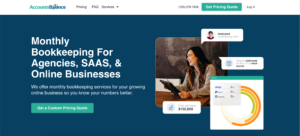
Do you know the essential bookkeeping tasks you should be on top of for your business?
Every business owner should know at least these basics! We’re covering them here, so you stay ahead of the game.
Daily Bookkeeping Tasks
A. Recording Transactions
Recording transactions is at the very core of any bookkeeping system. It involves making a note of all the financial activities of your business. These include tracking income, expenses, investments, and withdrawals. The process goes like this:
- Start by collecting documents that describe and serve as proof of each transaction. This includes receipts, invoices, bank statements, and canceled checks.
- You can use one of two record-keeping methods:
- Single-entry bookkeeping is simpler and more suitable for very small businesses. It only tracks income and expenses, though, so it doesn’t provide a complete financial picture.
- Double entry accounting is better for most businesses because it involves recording each transaction twice, ensuring all accounts balance.
- Categorize transactions into accounts based on their nature. The most common accounts are cash, accounts receivable, accounts payable, inventory, equipment, and owner’s equity.
- Record transactions in a journal (single-entry) or a general ledger (double-entry). A journal lists a chronological record of all transactions and a general ledger groups the transactions by account, showing debits and credits for each account.
B. Managing Accounts Payable and Accounts Receivable
Proper management of what you owe and what others owe you is crucial for your business’s financial well-being.
Accounts Payable is the money that your business owes to suppliers or vendors. This is for goods or services you purchased on credit. It essentially reflects a short-term liability on your balance sheet.
Accounts Receivable is the money that customers owe your business for goods or services that you sold them on credit. It reflects as a current asset on your balance sheet, since you would generally expect to collect the payments soon.
This is how a bookkeeper would manage these accounts:
Accounts Payable
- Make sure you set clear payment terms for invoice payments when placing orders so that you can track your deadlines. For instance, if you and the vendor agree on Net 30 payment terms, then you know exactly when you need to pay them.
- Maintain a system for recording and tracking all incoming invoices. Make sure you have the due dates and amounts owed for each one.
- Strategically prioritize bill payments so you can optimize your cash flow. Consider any early payment discounts that vendors offer.
- Try to pay promptly to build trust and maintain good relationships with suppliers. This can win you better pricing and terms in the future.
Accounts Receivable
- Create a professional invoice template to keep all the details clear.
- Issue invoices promptly after a sale, clearly stating the amount due, payment terms, and late payment penalties.
- Consider offering flexible payment terms with multiple payment options for your customers’ convenience. For example, you can offer support for credit cards, Apple Pay, PayPal, and the like.
- Consider running credit checks for larger purchases to minimize the risk of bad debt.
- Establish and implement a solid system for following up on overdue invoices. You can use an automated email system to send polite reminders and gradually escalate actions for late payments.
- Generate aging reports to check outstanding receivables. This helps you prioritize collections based on how long they’ve been overdue.
- Consider using accounting software to help you automate tasks like sending invoices, tracking due dates, and generating reports. This saves time and reduces the chance of errors.

C. Tracking Cash Flow
Cash flow is basically a look at how much money is coming in and going out over a specific period. An accurate measure of your cash flow gives you a clear picture of your business’s financial health. You can do it this way:
- Choose a method for tracking cash flow based on your needs:
- Spreadsheets are simple and free, but can be error-prone and time-consuming to maintain.
- Accounting Software streamlines data entry, automates calculations to avoid manual errors, and offers clean reports for easier analysis. Consider a tool that comes with a cash flow management app to help you track on-the-go.
- Identify and record all sources of income your business receives, like:
- Sales revenue from products or services.
- Customer payments for invoices.
- Investor contributions or loan proceeds.
- Identify and track all business expenses, like:
- Cost of goods sold (COGS) for inventory-based businesses.
- Rent, utilities, and other operating expenses.
- Payroll expenses.
- Loan payments and interest.
- Taxes.
- Categorize your cash inflows and outflows to help you identify areas of spending and potential cost-saving opportunities.
- Calculate cash flow using cash flow statements:
- Operating Cash Flow tracks the cash you generate from core business activities by subtracting operating expenses from revenue.
- Free Cash Flow shows you the cash you have available after accounting for all operating expenses and capital expenditures like equipment and property.
Weekly and Monthly Bookkeeping Tasks
A. Reconciling Bank and Credit Card Statements
Reconciling your bank and credit card statements involves comparing your financial records with official statements. These statements from your bank and credit card company help you to identify any discrepancies. Here’s the process:
- Gather your most recent bank statement and credit card statement for the reconciliation period, which is usually monthly.
- Log in to your bank account and credit card account online or through mobile banking.
- Review each transaction on your bank statement and match them with the withdrawals and deposits on your bank account records.
- Review each transaction on your credit card statement and identify the purchases that you made during the billing period. Compare these transactions with your bank records. Match amounts and dates for:
- Direct deposits from the credit card company reflecting your payment.
- Debits on your bank account that reflect charges from the credit card company for credit purchases.
- Investigate any unmatched transactions or discrepancies in amounts as soon as possible. Contact your bank or credit card company to clarify any unresolved discrepancies. Look for:
- Outstanding checks not yet reflected in your bank statement.
- Pending deposits that haven’t cleared yet.
- Errors by you, the bank, or the credit card company.
- Mark all matched transactions and resolved discrepancies on your statements and your bank account records.
- Consider recording outstanding debits or credits like uncleared checks in your accounting software or bookkeeping system.

B. Reviewing Financial Reports
Financial reports summarize your financial activities and position. This helps you understand your business’s financial health and performance so you can make informed decisions.
Key Financial Reports
- The Balance Sheet gives you a snapshot of your company’s financial position at a specific point in time. It shows your Assets, Liabilities, and Shareholders’ equity.
- The Income Statement, or Profit and Loss Statement, summarizes your business’s revenue and expenses over a specific period. You can do this monthly or quarterly.
- The Cash Flow Statement tracks how cash is moving in and out of your business. The categories are operating activities, investing activities, and financing activities. This report reveals how well your business generates cash to cover its expenses and obligations.
Here’s how to review the key financial reports effectively:
- Understand the purpose and structure of each report.
- Generate reports regularly so you can identify trends over time by comparing reports from different periods. Look for changes in revenues and expenses.
- Calculate financial ratios using report data, such as profitability, liquidity, and solvency. These ratios give you deeper insights into specific aspects of your financial performance.
- Compare your financial ratios to industry benchmarks and/or your competitors’ performance to get a look at your relative standing.\
- Pinpoint areas for improvement and brainstorm strategies to increase revenue, reduce expenses, and optimize cash flow management, as needed.
C. Analyzing Profit and Loss Statements
Your profit and loss statement helps you understand your business’s financial performance and profitability. Specifically, it shows how efficiently you’re generating revenue and managing expenses.
Analyzing Profit and Loss Effectively
Understand your business’s revenue and expenses over time:
- Revenue reflects all your income sources.
- Cost of Goods Sold (COGS) represents the direct costs associated with producing or acquiring products.
- Operating Expenses shows all indirect costs incurred to run your business.
- Gross Profit reflects your initial profit margin after subtracting COGS but before accounting for operating expenses.
- Operating Income (or Loss) is your gross profit minus operating expenses, relating to core business operations.
- Non-Operating Items includes income or expenses not directly related to your core business activities.
- Net Income (or Loss) is your overall profit (or loss) after accounting for all revenue, expenses, and non-operating items.
Apply Key Analysis Techniques
- Track your revenue growth over time.
- Calculate profit margins at different stages to see how much profit you generate at each stage from each dollar of revenue.
- Analyze your operating expenses by category to identify areas where you can cut costs or optimize spending.
- Compare your revenue and expenses to your budgeted amounts to identify any significant variances and adjust your plans accordingly.
- Compare your ratios to industry benchmarks or competitor performance to assess your relative profitability and efficiency.

Frequently Asked Questions
What is the difference between a bookkeeper and a CPA?
Bookkeepers and CPAs (Certified Public Accountants) are both financial professionals. Their areas of focus and day-to-day tasks is where they differ.
Bookkeepers focus on maintaining organized and accurate financial records. They record financial transactions like income and expenses, reconcile bank statements, manage accounts payable and receivable, etc. They might also prepare basic financial reports. Bookkeepers don’t need any formal licenses to work, but certifications can be beneficial.
CPAs focus on interpreting financial data, giving business owners insights and recommendations, and ensuring compliance with tax regulations. They commonly analyze financial data and prepare the more complex financial statements like balance sheets. They also prepare income statements, offer tax advice and planning, perform audits, and can provide business consulting services. CPAs need to pass the Uniform CPA exam to work.
Can a bookkeeper also provide tax preparation services?
A bookkeeper will not typically handle complex tax preparation, but lay the groundwork for it. They organize financial records, which makes tax filing smoother for a tax professional. Bookkeepers will usually collaborate with CPAs or Enrolled Agents who specialize in tax preparation.
However, a more experienced bookkeeper with additional training might be able to handle basic tax preparation. We don’t recommend using bookkeepers unless your tax situation is simple. Always ask a bookkeeper about their qualifications and experience in tax preparation before entrusting them with your return.

How often should I consult with a CPA for my business?
Simple businesses with steady income and expenses will not usually need to consult with a CPA more than once a quarter. Businesses with complex structures and inventory management or frequent financial transactions should meet with a CPA monthly.
We also recommend that new businesses consult monthly, regardless of structure or sales volume. This helps new owners make sure they are on top of things. Other businesses that are experiencing significant changes should also consider more frequent consultations. This helps them properly navigate tax implications and get financial planning advice.
Do I need both a bookkeeper and a CPA, or can one professional handle all my financial needs?
Whether you need both a bookkeeper and a CPA depends on how complex your business finances are.
- Hiring a bookkeeper only works if:
- Your business is small with straightforward finances.
- You can manage some financial tasks like generating reports, and basic tax preparation.
- You have bookkeeping software to make data entry easier.
- Hiring a CPA without a bookkeeper is a good idea if:
- You don’t require frequent record-keeping or can do it yourself.
- The CPA you hire is willing to do bookkeeping tasks.
- We recommend hiring both because:
- Bookkeepers charge lower rates, so your CPA can focus on complex tasks (tax planning, audits, etc) and providing you with broader financial guidance.
- Bookkeepers know how to provide clean data for the CPA to analyze and provide insights.
What are the typical fees associated with hiring a bookkeeper versus a CPA?
The fees for bookkeepers typically range from $10 to 70 per hour. Where you will land depends on their skills and experience, what you need done, and where you’re hiring from.
The fees for CPAs typically range from $150 to $450 per hour. What you will get quoted depends on their experience, location, industry specialization, and your business needs.
Note that some experts can charge more, especially for more complex tasks. Flat rates for one-off tasks are also common. Bookkeeping clean up fees, for example, can range from $100 to $250.
What Is AccountsBalance?

AccountsBalance is a monthly bookkeeping service specialized for agencies & SAAS companies.
We take monthly bookkeeping off your plate and deliver you your financial statements by the 15th or 20th of each month.
You’ll have your Profit and Loss Statement, Balance Sheet, and Cash Flow Statement ready for analysis each month so you and your business partners can make better business decisions.
Interested in learning more? Schedule a call with our CEO, Nathan Hirsch.
And here’s some free resources:
In Summary
By understanding the essential bookkeeping tasks that every business needs, you’ll be better equipped to deal with your finances. This will also help you navigate hiring and working with bookkeepers and accountants. The right fit will significantly improve the financial well-being of your business.








